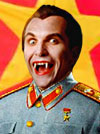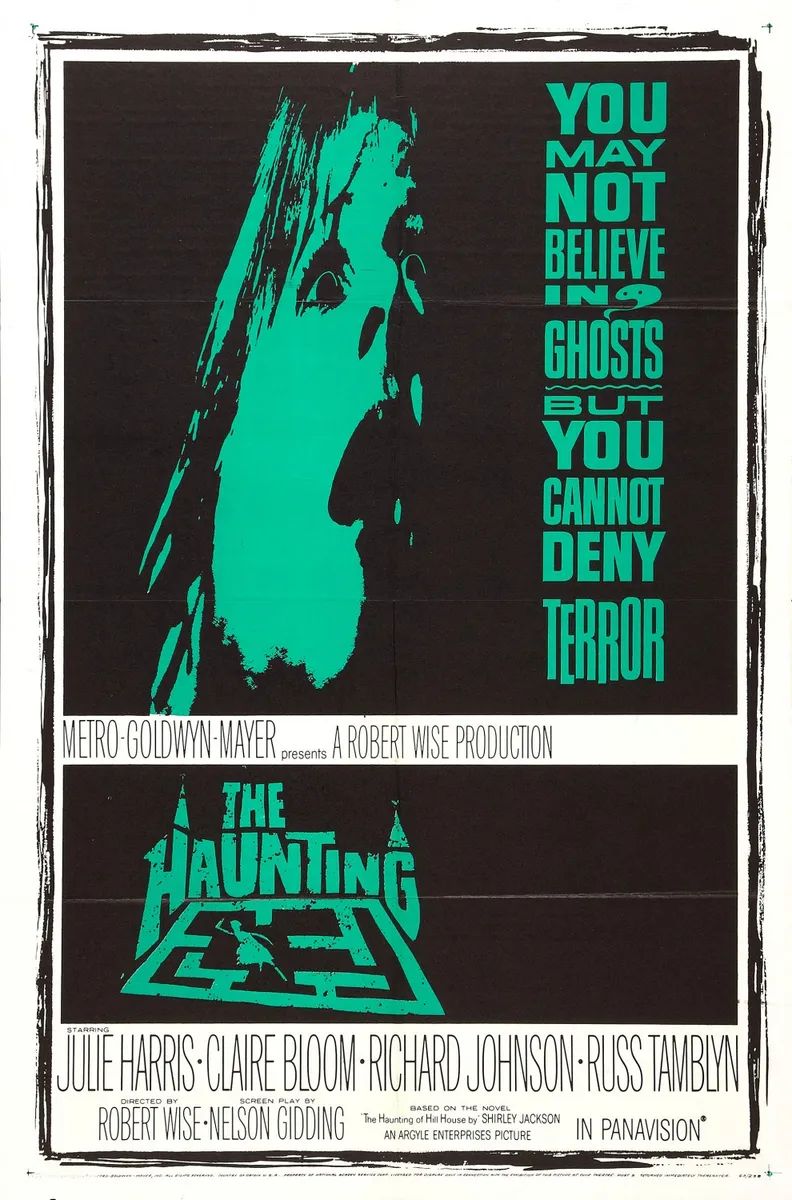|
The Haunting Film review by Thomas M. Sipos |
|
MENU Books Horror Film Festivals and Awards
Pursuits
Blogs Horror Film Festivals and Awards
Other
|
The Haunting (1963, dir: Robert Wise, scp: Nelson Gidding, based on the novel The Haunting of Hill House by Shirley Jackson, DP: David Boulton, cast: Julie Harris, Richard Johnson, Claire Bloom, Russ Tamblyn, Lois Maxwell, Rosalie Crutchley)
From this source material, Robert Wise directed the quintessential haunted house film, a horror masterpiece so sublime that remakes risk a poor comparison (the fate of Jan De Bont's pointless and inferior 1999 remake). Wise's The Haunting is faithful to the novel, with minor variations in name, emphasis, and exposition. Nelson Gidding's efficient script opens with Dr. Markway's narration of Hill House's history of fatal accidents, suicide, insanity, and murder. This immediately introduces the viewer to Hill House, a character in its own right. (Jackson had claimed to believe that houses had personalities). Dr. Markway (Richard Johnson) is an anthropologist seeking proof of the supernatural, and Hill House's unsavory history and reputation convince him that it's a good place to look. For assistance, he invites others with paranormal experience or talents to join him at Hill House. Nell (Julie Harris) is chosen because, during her childhood, rocks rained on her house for three days. Dr. Markway hopes her presence will attract genuine paranormal phenomena, although he leaves open the possibility that Nell is psychokinetic. His other guests are Theo (Claire Bloom), an artist with ESP gifts, and Luke (Russ Tamblyn), the playboyish heir to Hill House. Hill House's hauntings quickly focus on Nell, a timid and embittered woman who's sacrificed eleven years to nursing her sick and ungrateful mother. Although naive and unsophisticated, Nell looks older than her years. In the novel she is 32 yet claims to be 34, perhaps to spite herself. (Julie Harris was 38 when she did the film). Nell has long comforted herself with the belief that "someday, something will happen to her." When, shortly after Nell's mother dies, Dr. Markway invites Nell to Hill House, she thinks her turn at life has finally arrived.
The old saw that the scariest things are those suggested but left unseen, because no writer or filmmaker can surpass the audience's imagination, is often untrue. However, it's true enough in The Haunting, which is a paragon of bloodless horror. (What Stephen King calls terror rather than horror.) No ghost or gore is ever seen. Everything is suggested by light and shadow and sound, creating an uncanny atmosphere that frays the characters' nerves and aggravates their interpersonal tensions. David Boulton's black and white photography imbues those lights and shadows with supernatural menace, but The Haunting is especially noteworthy for its sound effects. Hill House's worst terrors are heard but never seen. Film students have long focused on conjuring scares with visual effects. The Haunting is instructive in all that may be accomplished with sound alone. Or at least, with sound and shadows. Sound and shadows collaborate in The Haunting, but so do shadows and set decor. Shirley Jackson described Hill House as looking so evil that guests were tempted to turn back. Yet all she says of Hill House's menacing countenance is that its angles and proportions were "not quite right." All else is left to the reader's imagination. (Jackson does mention that Hill House is encircled by a veranda and made of wood, save for a stone tower containing a library, but there's nothing especially menacing about that.) But as a filmmaker, Wise had to depict an evil-looking house visually. He cast Ettington Park for the role of Hill House (Ettington Hall, by some reports), a 200-year-old hotel that some regard as quite pleasant. To transform Ettington Park into something menacing, Wise shot the house with infrared film stock and a distorted 28mm lens. (Bryan Senn provides an excellent production history in Cinematic Hauntings.) The Haunting excels on all levels except background music, which is loud, melodramatic, and intrusive. Its cast is first-rate. Julie Harris effectively conveys Nell's timidity, her halting attempts to escape her protective shell, her inexperience making her easily tipsy after a little wine, her desperation to belong leading her to imagine love where it does not exist. Richard Johnson portrays a sincere and sympathetic scientist with a wry sense of self-deprecation (who went on to play villains in some of the finest B horror films of the late 1970s: Screamers, The Great Alligator, Zombie). Rosalie Crutchley's housekeeper provides comic relief and menace, simultaneously. Russ Tamblyn's playboy heir is callow and irreverent, and Claire Bloom's lesbian artist is somewhat catty, yet neither is entirely unsympathetic.
Some critics have made overmuch of Theo's lesbianism, making it the crux of their analysis. Phil Hardy is that rare critic who pans The Haunting, condemning the film as "a ponderous affair" (Overlook Film Encyclopedia: Horror). Yet Hardy's broad dismissal seems motivated by what he terms as the film's "bigoted" attitude toward lesbianism (Nell rebuffs Theo's advances, calling her "unnatural"). Conversely, David J. Hogan lauds The Haunting for depicting Theo's lesbian self-acceptance as healthier than Nell's repressed sexuality (Dark Romance: Sexuality in the Horror Film). Carol J. Clover goes so far as to infer (from the juxtaposition of Theo's remarks to Nell) a sublimated homosexuality between Dr. Markway and Luke (Men, Woman, and Chain Saws: Gender in the Modern Horror Film), a baseless interpretation. Such analyses embrace the PC notion that Theo's lesbianism must be deconstructed and adjudged before the film can be safely enjoyed; one cannot regard Theo as an independent character with good and bad traits, her lesbianism irrelevant, for to PC critics, issues of gender, class, and race are always foremost. Whatever else it is, and despite Hardy's pan, The Haunting (both the novel and the Wise film) is great entertainment and a milestone in the history of horror art. Review copyright by Thomas M. Sipos
|
"Communist Vampires" and "CommunistVampires.com" trademarks are currently unregistered, but pending registration upon need for protection against improper use. The idea of marketing these terms as a commodity is a protected idea under the Lanham Act. 15 U.S.C. s 1114(1) (1994) (defining a trademark infringement claim when the plaintiff has a registered mark); 15 U.S.C. s 1125(a) (1994) (defining an action for unfair competition in the context of trademark infringement when the plaintiff holds an unregistered mark).

 Shirley
Jackson's 1959 novel,
Shirley
Jackson's 1959 novel, 